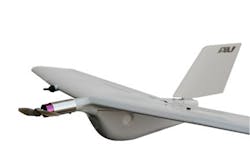Law-enforcement associations adopting unmanned aircraft guidelines; AUVSI applauds growing implementation
ARLINGTON, Va., 5 Sept. 2012. Three law-enforcement organizations--the Airborne Law Enforcement Association (ALEA), FBI Law Enforcement Executive Development Association (FBI – LEEDA), and FBI National Academy Associates (FBINAA)--have adopted guidelines from the International Association of Chiefs of Police (IACP) for the use of unmanned aircraft systems (UAS).
The guidelines provide law-enforcement agencies an outline of how to use UAS safely and responsibly, and with respect to individuals’ privacy, says a representative of the Association for Unmanned Vehicle Systems International (AUVSI), which applaudes the three agencies for its adoption and endorsement of the guidelines. Earlier this year, AUVSI’s released its “Code of Conduct” for professionals who design, test, and operate UAS.
“The unmanned aircraft industry applauds these organizations for adopting the IACP, which demonstrates their dedication to protecting communities, as well as the rights of the people within those communities,” says Michael Toscano, president and CEO of AUVSI. “Unmanned aircraft help law enforcement agencies with missions such as search and rescue, crime scene photography, and other dangerous or difficult tasks, often at a lower cost than manned aircraft. The IACP guidelines, which won praise from privacy advocates, and their adoption by others within the law enforcement community, exemplify the community’s commitment to use this technology responsibly and with respect to the individual rights we all cherish.”
The IACP guidelines adopted by ALEA, FBI-LEEDA, and FBINAA (http://www.theiacp.org/portals/0/pdfs/IACP_UAGuidelines.pdf ) cover community engagement, system requirements, operational procedures, and image retention. They direct law-enforcement agencies to engage with the community, specifically their governing body and civil liberties advocates, about how UAS will be used and protections put in place to uphold citizens’ rights. The guidelines also encourage notifying those living and working in the vicinity of aircraft operations, when possible. The guidelines call for a transparent implementation process for agencies desiring UAS, including a period of public comment.
The guidelines include specific steps law enforcement should take to respect the privacy of individuals:
• Where there are specific and articulable grounds to believe that the (unmanned aircraft) will collect evidence of criminal wrongdoing and if the (unmanned aircraft) will intrude upon reasonable expectations of privacy, the agency will secure a search warrant prior to conducting the flight.
• Unless required as evidence of a crime, as part of an on-going investigation, for training, or required by law, images captured by a UA should not be retained by the agency.
• Unless exempt by law, retained images should be open for public inspection.
